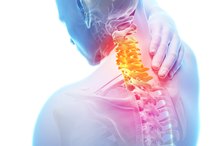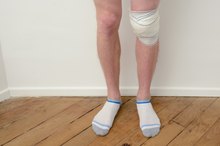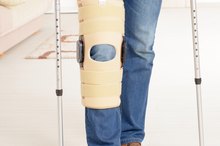Exercises for Adhesive Capsulitis of the Hip
Adhesive capsulitis is a condition characterized by pain, stiffness and decreased range of motion of a joint. It occurs when the capsule, or the connective tissue surrounding your joint, becomes thick and stiff. Until recently, this condition had only been thought to occur in the shoulder. A study in published in 2006 in “Arthroscopy” identified the first nine cases of “frozen hip.” The researchers in this study postulated that many people will be able to improve with exercise, while manipulation under anesthesia and arthroscopy may be required for others.
Risk Factors
Middle-aged women appear to have the highest risk, according to “Arthroscopy,” with the most commonly reported range between 36 and 49 years of age. Adhesive capsulitis may also occur idiopathically, with no real cause known. Other risk factors include extended periods of immobility, such as an injury, stroke, recuperation from surgery and certain diseases such as diabetes, hypothyroidism, hyperthyroidism, Parkinson’s disease and tuberculosis.
Exercise
What Are the Treatments for a Bone Spur in the Shoulder?
Learn More
The saying “use it or lose it” most certainly applies to adhesive capsulitis. Stretching exercises are an integral component of treatment for adhesive capsulitis. Stretching helps restore range of motion, decrease pain and prevent the joint from becoming stiff. Stretches may include passive stretches, active assist stretches and active stretches. Exercises for adhesive capsulitis should be performed under the guidance of a physical therapist or doctor only. Attempting to self-diagnose this condition or perform exercises at home may result in worsening of your condition or injury. Early diagnosis is best to improve your chance for a full recovery.
Studies
Although there is no published literature demonstrating the effectiveness of physical therapy on adhesive capsulitis of the hip, there are several studies suggesting a positive effect in patients with adhesive capsulitis of the shoulder. A 2004 study published in the “Journal of the Medical Association of Thailand” found that 35 percent of individuals participating in physical therapy experienced an improvement in symptoms after three weeks, compared to 18.6 percent of individuals who did not undergo physical therapy. The therapy consisted of mobilization exercises and passive stretching of the joint three days a week with a physical therapist, along with active assisted and active non-assisted exercises for five minutes on the rest of the days of the week at home.
Time Frame
Cervical Traction Contraindications
Learn More
Most patients with idiopathic causes recover with conservative treatment alone over a period of five to 24 months, according to “Arthroscopy.”
Considerations
Exercise should be combined with other conservative measures such as nonsteroidal anti-inflammatories, heat, avoidance of painful activities and corticosteroid injections. Manipulation under anesthesia followed by arthroscopic surgery to release the capsule may be required if you do not achieve adequate relief with conservative measures. Those with a pre-existing condition of the hip typically require surgery.
Related Articles
References
Writer Bio
Kimberly Rienecke started her career as a health and fitness writer by working for various websites. She is a certified orthopedic physician assistant and an ACE-certified personal trainer. She also holds a Bachelor of Science in biology from Towson University.








